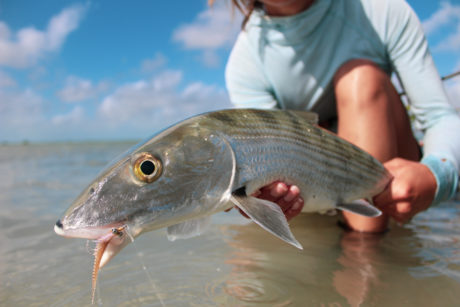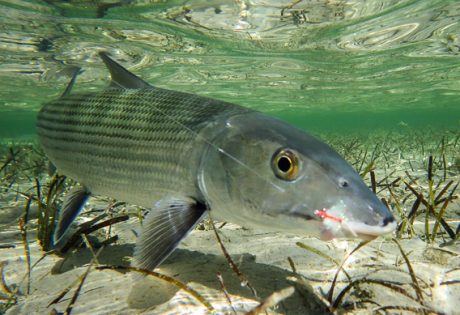
To succeed on the flats, a precise strip set execution is essential. A successful strip set involves more than just yanking on the fly line when the fish takes the fly. Here are a few tips on how to execute a better strip set while on the flats.
8 Tips to a Better Strip Set
You’ve done everything right so far… You’ve made an accurate cast, presented the fly, and now the fish is about to eat! Let’s pause right here. This is the moment where every nerve in your body is vibrating. The peak of excitement in fly fishing is upon you and it takes a little practice to keep your cool and deliver the proper hook set. This little detail can be the difference between landing dozens of fish or going home with a score to be settled for next time. Here are a handful of tips that will help you be more successful and land more fish the next time you hit the flats.
- Relax & Just Breathe. Seeing a fish on the flat heading towards your fly can rattle anyone, but remember to simply breathe deeply. Try a breathing pattern that will calm your nerves. Inhale while counting to 4 seconds in your head, then exhale for 6 seconds. A longer exhale will send signals to your brain and nervous system that it is okay to be calm and your heart rate will slow as a result. Focusing on your breathing will help to keep you in the present moment, where you belong.
- Ready Position. Just like any athletic pursuit, fly fishing also has a ready position. As you present and strip the fly in, think to yourself, am I positioned properly to strip set? You may find that your strip set hand may not have enough room to deliver the proper set. Position yourself on the shore or boat in a way that you can deliver your best strip set by planting your body in the right position first. Try a couple of mock strip sets as you plant your feet and begin to cast.
- Visualize. We hear a lot about visualization in sports today, frankly because it works. If you are aimlessly stripping your fly back to the tip of your rod thinking about an upcoming deadline your chance of being caught off guard is much more likely. Visualize a fish trailing your fly and closing in. Then, visualize exactly how you will strip set, ensuring you are ready and in a good position to connect with the fish. You don’t have to do it on every retrieve, but use visualization to get your head in the game.
- Rod Tip Down. As you begin to retrieve your fly make sure that your rod tip is pointing down, almost touching the water. By pointing your rod tip down and at your fly, you are removing slack from your fly line. When you go to strip set, you will be able to pull tight on the hook since there is no slack anywhere in your fly line.
- Remove Slack. After you make a presentation cast, notice if your line has rolled out nicely in front of you without slack. If your fly line and/or leader didn’t completely unroll, quickly strip the slack out of your line until you have a direct connection to your fly. If you leave the slack too long, you may get an eat on your fly, and have the fish spit it out before you even know what happened.
- Respond to the Fish. The direction and speed at which your target is moving will greatly affect the hook set. With a fish charging directly at your fly, you have to keep stripping fast in order to get pressure on the hook. This may take several long strip sets to finally get some purchase on the fish before it decides to turn and run. When the fish is moving away from you and eats your fly, you may take the opposite approach. You won’t need a long aggressive set. Instead, you’ll need just enough pressure to feel the tug of the fish in order to bury the hook. The point is to watch how the fish is moving and adjust your hook set to best suit the situation.
- Don’t Trout Set. The most common mistake when strip setting is lifting the rod tip to the sky when the fish eats, just like you would when dry fly fishing on a western river. On the flats, ‘trout setting’ is a great way to keep fish off the end of your line. It creates slack, gives the fish time to spit the fly, and it doesn’t give us the proper pressure to stick a hook in the hard mouth of a saltwater fish. If you remember one thing the next time you’re fishing… keep your rod tip down during your strip set. It’s a hard habit to break, but once it’s ingrained you’ll even strip set when throwing streamers for trout.
- Develop a Soft “Touch.” To get really dialed in, here’s a trick that will allow you to apply just the right amount of pressure on your hook set. A perfect set will bury the hook in your target but too much pressure can break your line or even hurt the fish in some cases. With the fly line pinched between the thumb and pointer finger of your stripping hand, you have the ability to regulate pressure to allow the fly line to slide between your fingers. Once you feel pressure from a fish, you can continue to pull on that strip set but as that fish turns and quickly runs it’s important to react quickly, allowing the line to slide through your line hand. If you pinch down on the line when the fish turns and runs, the odds are you’ll break that fish right off. By lightening the pressure you are applying, the line can then slide through your hand as the fish runs. If you need to give an extra-strong hook set to a big fish with a hard mouth, then you can easily clamp down harder on that fly line between your thumb and pointer finger. Gear and tippet strength are a big x-factor when we talk about applying pressure to fish so keep that in mind. Being conscious of this trick will enable you to put just the right amount of pressure on the fish when setting the hook in any situation.

More Flats Fishing Tips
- 6 Tips for Bonefishing in Windy Conditions
- Casting Sidearm for Bonefish – 3 Benefits
- Clearing Line for Bonefish – 7 Tips
Leave a Reply